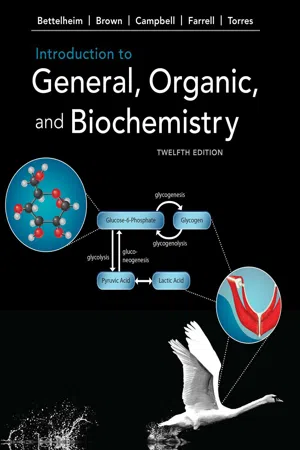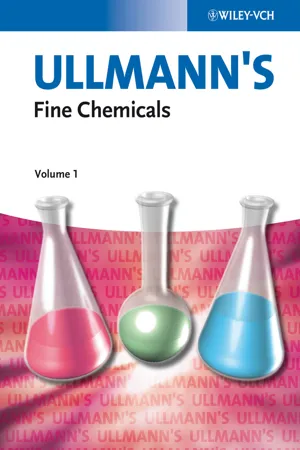Chemistry
Carboxylic Acids
Carboxylic acids are organic compounds containing a carboxyl group (COOH). They are characterized by their acidic properties and are found in many natural substances, such as vinegar and citrus fruits. Carboxylic acids are important in organic synthesis and are used in the production of pharmaceuticals, fragrances, and polymers.
Written by Perlego with AI-assistance
Related key terms
1 of 5
8 Key excerpts on "Carboxylic Acids"
- eBook - PDF
- H. Stephen Stoker(Author)
- 2015(Publication Date)
- Cengage Learning EMEA(Publisher)
A carboxylic acid is an organic compound whose functional group is the car-boxyl group. What is a carboxyl group? A carboxyl group is a carbonyl group (C O) that has a hydroxyl group ( ! OH) bonded to the carbonyl carbon atom. A general structural representation for a carboxyl group is C O O O B OH O Copyright 2016 Cengage Learning. All Rights Reserved. May not be copied, scanned, or duplicated, in whole or in part. Due to electronic rights, some third party content may be suppressed from the eBook and/or eChapter(s). Editorial review has deemed that any suppressed content does not materially affect the overall learning experience. Cengage Learning reserves the right to remove additional content at any time if subsequent rights restrictions require it. 158 CHAPTER 5 Carboxylic Acids, Esters, and Other Acid Derivatives Abbreviated linear designations for the carboxyl group are ! COOH and ! CO 2 H Although a carboxyl group contains both a carbonyl group (C O) and a hydroxyl group ( ! OH), the carboxyl group does not show characteristic behavior of either an alcohol or a carbonyl compound (aldehyde or ketone). Rather, it is a unique functional group with a set of characteristics different from those of its component parts. ◀ The simplest carboxylic acid has a hydrogen atom attached to the carboxyl group carbon atom. C O O B OH O H Structures for the next two simplest Carboxylic Acids, those with methyl and ethyl alkyl groups, are C O O O B OH O CH 2 CH 3 C O O B OH O CH 3 The structure of the simplest aromatic carboxylic acid involves a benzene ring to which a carboxyl group is attached. C O OH O B Cyclic Carboxylic Acids do not exist; having the carboxyl carbon atom as part of a ring system creates a situation where the carboxyl carbon atom would have five bonds. The nonexistence of cyclic Carboxylic Acids parallels the nonexistence of cyclic aldehydes (Section 4-3). - eBook - PDF
- Ramesh Chandra, Snigdha Singh, Aarushi Singh(Authors)
- 2019(Publication Date)
- Arcler Press(Publisher)
The most important functional group that present are the Carboxylic Acids C=O. This sort of organic compounds can be attained by different ways, some Carboxylic Acids, for example, fumaric acid, citric acid or lactic acid are formed from by fermentation most of these kinds of Carboxylic Acids are useful in the food industry (Oguz et al., 2017). The general formula of the carboxylic acid is R-COOH, were as COOH indicates the carboxyl group, while R indicates the rest of the particle to which this group is connected. In this carboxyl group, there occurs a carbon which has a double bond with an oxygen atom and a single bond with a hydroxyl group (OH). The general arrangement of a carboxylic acid (COOH) is shown below. Figure 5.1: General structural arrangement of a carboxylic acid. [Source: https://byjus.com/chemistry/carboxylic-acid-properties/] From the illustration provided above, it can be perceived that a carboxylic acid has a hydroxyl group attached to a carbonyl carbon. Because of the electronegativity of the oxygen atom, this functional group can experience ionization and release a proton (Gedye et al., 1986; Yasa et al., 2017). The carboxylate ion, formed from the elimination of a proton from the carboxyl group, is stabilized by the existence of two oxygen atoms (through Carboxylic Acid Reactions and Uses 167 which the (-) negative charge can transfer). Some common examples of Carboxylic Acids contain Formic acid and acetic acid (a component of vinegar). 5.2. NOMENCLATURE OF Carboxylic Acids Normally, these organic compounds are discussed by their insignificant names, which hold the suffix “-ic acid.” An instance of an insignificant name for a carboxylic acid is acetic acid (CH 3 COOH) . In the IUPAC terminology of these compounds, the postfix “-oic acid” is given. The recommendations that must be followed in the IUPAC terminology of Carboxylic Acids are listed beneath (Roughley & Jordan, 2011). - eBook - ePub
Understanding Advanced Organic and Analytical Chemistry
The Learner's ApproachRevised Edition
- Kim Seng Chan, Jeanne Tan;;;(Authors)
- 2016(Publication Date)
- WS EDUCATION(Publisher)
CHAPTER 10
Carboxylic Acids and Their Derivatives
10.1 Introduction
Carboxylic Acids are organic compounds that contain the following carboxyl functional group, denoted as –COOH.From the constitutional/structural formula, the carboxyl functional group is a composite of a carbonyl functional group and a hydroxyl group. Similar to that in carbonyl compounds, the carbon atom of the carboxyl functional group is sp2 hybridized and trigonal planar in shape. Thus, it is not surprising that Carboxylic Acids possess physical and chemical properties similar to both the carbo nyl and hydroDerivatives of Carboxylic Acids have the –OH group substituted. For instance, esters contain the functional group –COOR, and acid chlorides the –COCl group.xylcompounds.10.2 Nomenclature
Carboxylic Acids are named with the suffix –oic acid. Other substituents are named as prefixes accompanied by the appropriate positional numbers. If the carboxylic acid group is considered a substituent, then it is named as the –carboxy prefix (notice that the prefix is not “carboxyl”).10.3 Physical Properties
10.3.1 Melting and Boiling Points
Melting and boiling points increase with increasing carbon chain length (Table 10.1 ) and decrease with increasing degree of branching. As with alcohols, the trend is accounted for by the increasing strength of instantaneous dipole–induced dipole (id–id) attractive forces due to the greater number of electrons accompanying the increasing carbon chain length, rather than hydrogen-bonding.Table 10.1The boiling points of Carboxylic Acids are higher than those of their isomeric ester counterparts (Table 10.2 - Frederick Bettelheim, William Brown, Mary Campbell, Shawn Farrell(Authors)
- 2019(Publication Date)
- Cengage Learning EMEA(Publisher)
476 Carboxylic Acids 17 CONTENTS 17.1 Carboxylic Acids 17.2 Names of Carboxylic Acids 17.3 Physical Properties of Carboxylic Acids 17.4 Soaps and Detergents 17.5 Characteristic Reactions of Carboxylic Acids 17.1 Carboxylic Acids In this chapter, we study Carboxylic Acids, another class of organic com-pounds containing the carbonyl group. The carboxylic acid functional group can be represented in any one of three ways: 9 C 9 OH 9 COOH 9 CO 2 H O 17.2 Names of Carboxylic Acids A. IUPAC Names The longest carbon chain that contains the carboxylic acid functional group is used to obtain the IUPAC name of an acyclic carboxylic acid. Drop the final -e from the name of the parent alkane and replace it with -oic acid. Number the chain beginning with the carbonyl carbon of the carboxylic acid. Because this carbonyl carbon is understood to be carbon 1, there is no © Ruslan Mitin/Shutterstock.com These foods can contain low levels of harmful trans fats. Copyright 2020 Cengage Learning. All Rights Reserved. May not be copied, scanned, or duplicated, in whole or in part. Due to electronic rights, some third party content may be suppressed from the eBook and/or eChapter(s). Editorial review has deemed that any suppressed content does not materially affect the overall learning experience. Cengage Learning reserves the right to remove additional content at any time if subsequent rights restrictions require it. need to give it a number in the final IUPAC name. In the following exam-ples, the common name is given in parentheses. 3-Methylbutanoic acid (Isovaleric acid) OH O 1 3 Hexanoic acid (Caproic acid) OH O 1 6 4 When a carboxylic acid also contains an i OH (hydroxyl) group, we indi-cate its presence by adding the prefix hydroxy -. When it contains a primary (1°) amine, we indicate the presence of the i NH 2 group with amino -. When a carboxylic acid also contains a ketone or aldehyde group, we indicate the presence of that group by the prefix -oxo .- Stefanos Mourdikoudis(Author)
- 2021(Publication Date)
- Royal Society of Chemistry(Publisher)
Their chemical structure contains a carbonyl function (–C=O) and a hydroxyl group (OH). These groups interact easily with polar compounds, forming bridges of H and obtaining high boiling points. The carbonyl group (C=O) is considered one of the most functional groups involved in many important reactions. The Carboxylic Acids are the foremost important functional group that present C=O. 11, 12 Under certain conditions, proton donors i.e. Carboxylic Acids, transfer H + (protons) through heterolysis. This type of organic compound can be obtained by different routes: some Carboxylic Acids, such as citric acid, lactic acid, or fumaric acid, are produced by fermentation, and most of these types of Carboxylic Acids are applied in the food industry. 13 Historically, some Carboxylic Acids were produced by sugar fermentation. There are numerous synthesis reactions of Carboxylic Acids, like oxidation from alcohols within the presence of strong oxidants like KMnO 4 and oxidation of aromatic compounds among other routes. 14 Derivatives of carboxylic acid, such as alkyl halides, esters, and amides, find different applications in diverse areas. In the case of esters, these are obtained from the reaction between Carboxylic Acids and alcohols in the presence of an acid catalyst, usually H 2 SO 4, with heat; this type of reaction is known as esterification. 15 In the case of the amides, they are obtained in the presence of an amine, which can be primary and secondary, with a carboxylic acid- eBook - ePub
- Robert J. Ouellette, J. David Rawn(Authors)
- 2015(Publication Date)
- Elsevier(Publisher)
11Carboxylic Acids and Esters
11.1 Carboxylic Acids and Acyl Groups
In this chapter we will consider the structure, properties, and reactions of Carboxylic Acids. These compounds have a carboxyl group bonded to a hydrocarbon unit that can be saturated, unsaturated,The carboxyl carbon atom is sp2 -hybridized, and three of its valence electrons form three σ bonds at 120° angles to one another (Figure 11.1 ). One of the σ bonds is to a hydrogen atom or a carbon atom of an alkyl, aromatic, or heterocyclic group. The other two σ bonds are to oxygen atoms: one to the hydroxyl oxygen atom and the other to the carbonyl oxygen atom. The carbonyl carbon atom of the carboxyl group also has one electron in a 2p orbital forming a π bond with an electron in a 2p orbital of the carbonyl oxygen atom.Figure 11.1 Bonding in Carboxylic AcidsAlthough the bond angles at the carboxyl carbon atom are all approximately 120°, the carboxyl group is often represented with only vertical and horizontal lines. To save space, two condensed representations of the carboxyl group are commonly used. Unless required to account for the mechanism of a reaction, the nonbonding electrons are not shown.Equivalent representations of Carboxylic AcidsThe Acyl Group and Carboxylic Acid Derivatives
The “RCO” unit contained in a carboxylic acid is called an acyl group. Several families of acid derivatives have oxygen-containing groups or electronegative atoms, such as nitrogen or a halogen, in place of the OH group of a carboxylic acid. This group, represented by L, can be replaced in a nucleophilic acyl substitution reaction (Section 11.6 ).If an alkoxy (–OR) or phenoxy (–OAr) group is bonded to the acyl group, the derivative is an ester. Esters are formed from a carboxylic acid and an alcohol in a condensation reaction (Section 11.8 ). Esters are moderately reactive toward water in hydrolysis reactions and produce a carboxylic acid and an alcohol (Section 11.9 - eBook - ePub
- (Author)
- 2014(Publication Date)
- Wiley-VCH(Publisher)
Aliphatic hydroxyCarboxylic Acids may have one or several hydroxyl groups, together with one or more carboxyl groups. In the simplest case, the monohydroxymonoCarboxylic Acids, the compounds can be conveniently subdivided into three categories:1. 2- or α -hydroxyCarboxylic Acids,2. 3- or β-hydroxyCarboxylic Acids, and3. hydroxyCarboxylic Acids with the hydroxyl group located in the 4- (i.e., γ -) position, or even more remote from the carboxyl group.Table 1 lists several commercially important hydroxyCarboxylic Acids and related compounds, grouped in accordance with the above scheme.Table 1. Commercially important hydroxyCarboxylic Acids and derivatives.2. General Characteristics
The overall characteristics of a hydroxycarboxylic acid are a function of the number of hydroxyl and carboxylic acid groups present as well as their relative placement.2.1. Physical Properties
Most naturally occurring hydroxyCarboxylic Acids are chiral and thus exhibit optical activity. In pure form, they are usually crystallizable. HydroxyCarboxylic Acids have exceptionally high boiling points relative to corresponding unsubstituted acids with the same chain length. This is a consequence of association among the hydroxyl groups. For this reason, many of these compounds cannot be distilled without decomposition, even under vacuum.Table 2 summarizes the physical properties of the commercially important hydroxyCarboxylic Acids and their derivatives listed in Table 1 .Table 2. Physical properties of the hydroxyCarboxylic Acids listed in Table 12.2. Chemical Properties
HydroxyCarboxylic Acids readily form the expected salts at the carboxyl group. The acidity of α - eBook - PDF
- William H. Brown, Thomas Poon(Authors)
- 2017(Publication Date)
- Wiley(Publisher)
• The functional group of a carboxylic anhydride is two acyl groups bonded to an oxygen. • Symmetrical anhydrides are named by changing the suffix acid in the name of the parent carboxylic acid to anhydride. • The functional group of a carboxylic ester is an acyl group bonded to OR or OAr. • An ester is named by giving the name of the alkyl or aryl group bonded to oxygen first, followed by the name of the acid, in which the suffix ‐ic acid is replaced by the suffix ‐ate. • A cyclic ester is given the name lactone. • The functional group of an amide is an acyl group bonded to a trivalent nitrogen. • Amides are named by dropping the suffix ‐oic acid from the IUPAC name of the parent acid, or ‐ic acid from its common name, and adding ‐amide. • A cyclic amide is given the name lactam. 14.2 What Are the Characteristic Reactions of Carboxylic Acid Derivatives? • A common reaction theme of functional derivatives of car- boxylic acids is nucleophilic acyl addition to the carbonyl carbon to form a tetrahedral carbonyl addition intermedi- ate, which then collapses to regenerate the carbonyl group. The result is nucleophilic acyl substitution. 14.3 What Is Hydrolysis? • Hydrolysis is a chemical process whereby a bond (or bonds) in a molecule is broken by its reaction with water. • Hydrolysis of a carboxylic acid derivative results in a car- boxylic acid. 14.4 How Do Carboxylic Acid Derivatives React with Alcohols? • Carboxylic acid derivatives (except for amides) react with alcohols to give esters. • The reaction conditions required (i.e., neutral, acidic, or basic) depend on the type of derivative. 14.5 How Do Carboxylic Acid Derivatives React with Ammonia and Amines? • Carboxylic acid derivatives (except for amides) react with ammonia and amines to give amides.
Index pages curate the most relevant extracts from our library of academic textbooks. They’ve been created using an in-house natural language model (NLM), each adding context and meaning to key research topics.







